Health Problem: Euthanasia and Assisted Suicide Research Report in USA
VerifiedAdded on 2023/06/08
|15
|4427
|311
Report
AI Summary
This report delves into the complex issue of euthanasia and assisted suicide within the United States, examining its various forms—voluntary, non-voluntary, and involuntary—and their legal and ethical implications. The report provides a historical overview, tracing the evolution of the debate and legal precedents. It explores the arguments for and against euthanasia, including the role of terminal illness and brain death, and considers the perspectives of patients, families, and healthcare providers. The research utilizes a literature review, PICO table, and evidence matrix to analyze the necessity of euthanasia, the types of illnesses that might prompt it, and the impact on all involved parties. It concludes with a discussion of recommended practice changes, identification of key stakeholders, potential barriers, and strategies to overcome them, ultimately aiming to provide a comprehensive understanding of the issue and its impact on the health sector.
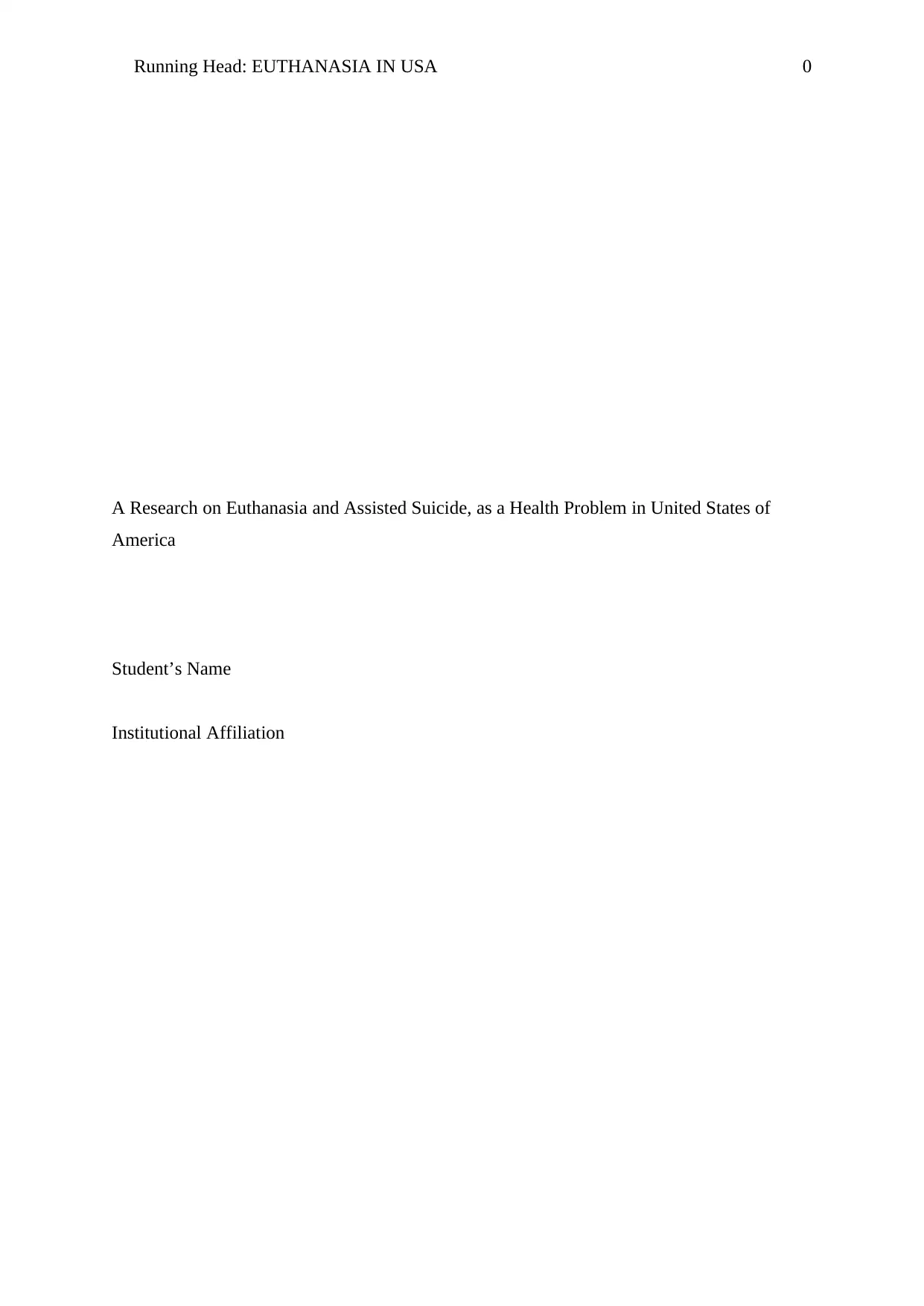
Running Head: EUTHANASIA IN USA 0
A Research on Euthanasia and Assisted Suicide, as a Health Problem in United States of
America
Student’s Name
Institutional Affiliation
A Research on Euthanasia and Assisted Suicide, as a Health Problem in United States of
America
Student’s Name
Institutional Affiliation
Paraphrase This Document
Need a fresh take? Get an instant paraphrase of this document with our AI Paraphraser
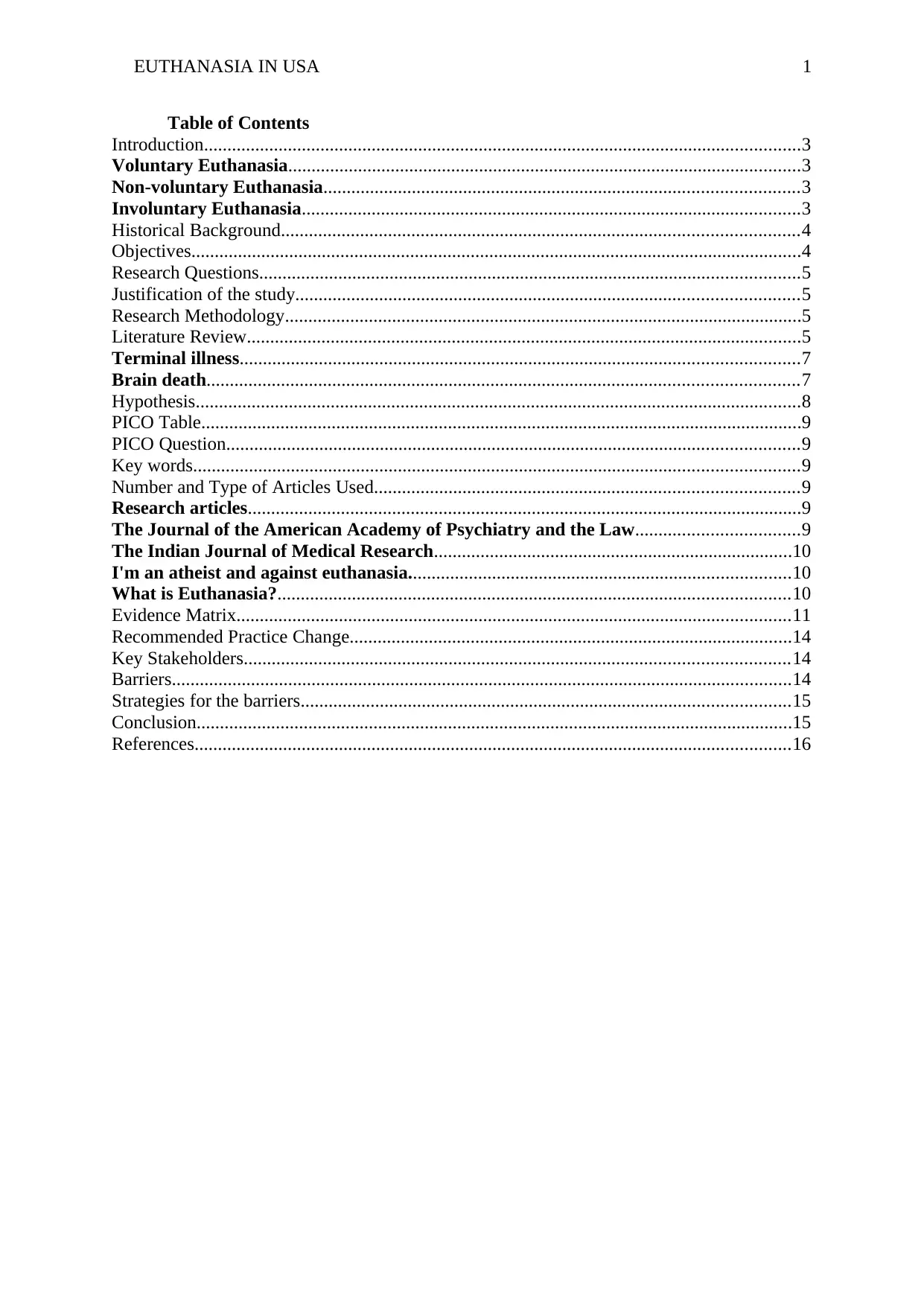
EUTHANASIA IN USA 1
Table of Contents
Introduction................................................................................................................................3
Voluntary Euthanasia..............................................................................................................3
Non-voluntary Euthanasia......................................................................................................3
Involuntary Euthanasia...........................................................................................................3
Historical Background...............................................................................................................4
Objectives...................................................................................................................................4
Research Questions....................................................................................................................5
Justification of the study............................................................................................................5
Research Methodology...............................................................................................................5
Literature Review.......................................................................................................................5
Terminal illness........................................................................................................................7
Brain death...............................................................................................................................7
Hypothesis..................................................................................................................................8
PICO Table.................................................................................................................................9
PICO Question...........................................................................................................................9
Key words..................................................................................................................................9
Number and Type of Articles Used...........................................................................................9
Research articles.......................................................................................................................9
The Journal of the American Academy of Psychiatry and the Law...................................9
The Indian Journal of Medical Research.............................................................................10
I'm an atheist and against euthanasia..................................................................................10
What is Euthanasia?..............................................................................................................10
Evidence Matrix.......................................................................................................................11
Recommended Practice Change...............................................................................................14
Key Stakeholders.....................................................................................................................14
Barriers.....................................................................................................................................14
Strategies for the barriers.........................................................................................................15
Conclusion................................................................................................................................15
References................................................................................................................................16
Table of Contents
Introduction................................................................................................................................3
Voluntary Euthanasia..............................................................................................................3
Non-voluntary Euthanasia......................................................................................................3
Involuntary Euthanasia...........................................................................................................3
Historical Background...............................................................................................................4
Objectives...................................................................................................................................4
Research Questions....................................................................................................................5
Justification of the study............................................................................................................5
Research Methodology...............................................................................................................5
Literature Review.......................................................................................................................5
Terminal illness........................................................................................................................7
Brain death...............................................................................................................................7
Hypothesis..................................................................................................................................8
PICO Table.................................................................................................................................9
PICO Question...........................................................................................................................9
Key words..................................................................................................................................9
Number and Type of Articles Used...........................................................................................9
Research articles.......................................................................................................................9
The Journal of the American Academy of Psychiatry and the Law...................................9
The Indian Journal of Medical Research.............................................................................10
I'm an atheist and against euthanasia..................................................................................10
What is Euthanasia?..............................................................................................................10
Evidence Matrix.......................................................................................................................11
Recommended Practice Change...............................................................................................14
Key Stakeholders.....................................................................................................................14
Barriers.....................................................................................................................................14
Strategies for the barriers.........................................................................................................15
Conclusion................................................................................................................................15
References................................................................................................................................16
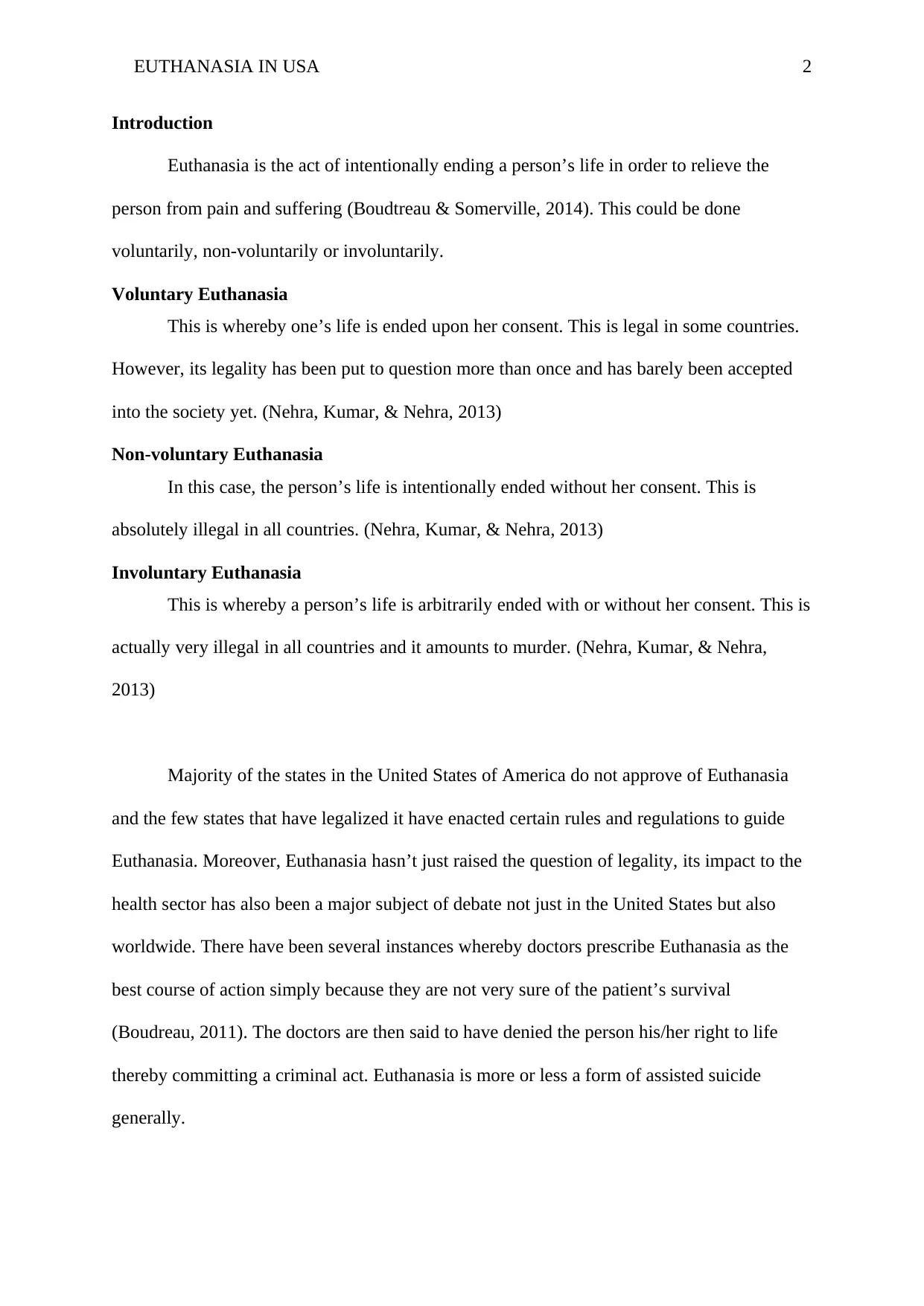
EUTHANASIA IN USA 2
Introduction
Euthanasia is the act of intentionally ending a person’s life in order to relieve the
person from pain and suffering (Boudtreau & Somerville, 2014). This could be done
voluntarily, non-voluntarily or involuntarily.
Voluntary Euthanasia
This is whereby one’s life is ended upon her consent. This is legal in some countries.
However, its legality has been put to question more than once and has barely been accepted
into the society yet. (Nehra, Kumar, & Nehra, 2013)
Non-voluntary Euthanasia
In this case, the person’s life is intentionally ended without her consent. This is
absolutely illegal in all countries. (Nehra, Kumar, & Nehra, 2013)
Involuntary Euthanasia
This is whereby a person’s life is arbitrarily ended with or without her consent. This is
actually very illegal in all countries and it amounts to murder. (Nehra, Kumar, & Nehra,
2013)
Majority of the states in the United States of America do not approve of Euthanasia
and the few states that have legalized it have enacted certain rules and regulations to guide
Euthanasia. Moreover, Euthanasia hasn’t just raised the question of legality, its impact to the
health sector has also been a major subject of debate not just in the United States but also
worldwide. There have been several instances whereby doctors prescribe Euthanasia as the
best course of action simply because they are not very sure of the patient’s survival
(Boudreau, 2011). The doctors are then said to have denied the person his/her right to life
thereby committing a criminal act. Euthanasia is more or less a form of assisted suicide
generally.
Introduction
Euthanasia is the act of intentionally ending a person’s life in order to relieve the
person from pain and suffering (Boudtreau & Somerville, 2014). This could be done
voluntarily, non-voluntarily or involuntarily.
Voluntary Euthanasia
This is whereby one’s life is ended upon her consent. This is legal in some countries.
However, its legality has been put to question more than once and has barely been accepted
into the society yet. (Nehra, Kumar, & Nehra, 2013)
Non-voluntary Euthanasia
In this case, the person’s life is intentionally ended without her consent. This is
absolutely illegal in all countries. (Nehra, Kumar, & Nehra, 2013)
Involuntary Euthanasia
This is whereby a person’s life is arbitrarily ended with or without her consent. This is
actually very illegal in all countries and it amounts to murder. (Nehra, Kumar, & Nehra,
2013)
Majority of the states in the United States of America do not approve of Euthanasia
and the few states that have legalized it have enacted certain rules and regulations to guide
Euthanasia. Moreover, Euthanasia hasn’t just raised the question of legality, its impact to the
health sector has also been a major subject of debate not just in the United States but also
worldwide. There have been several instances whereby doctors prescribe Euthanasia as the
best course of action simply because they are not very sure of the patient’s survival
(Boudreau, 2011). The doctors are then said to have denied the person his/her right to life
thereby committing a criminal act. Euthanasia is more or less a form of assisted suicide
generally.
⊘ This is a preview!⊘
Do you want full access?
Subscribe today to unlock all pages.

Trusted by 1+ million students worldwide
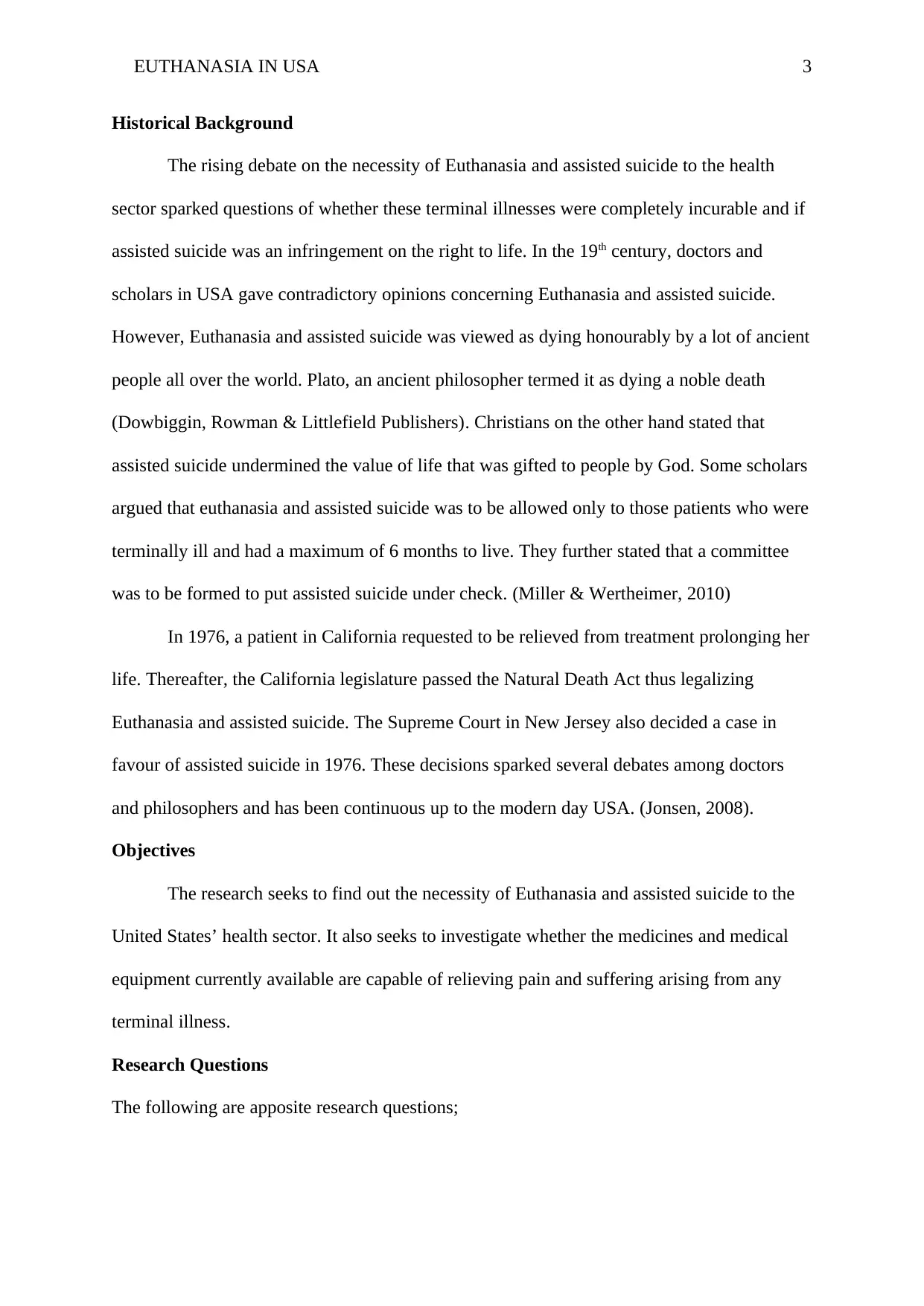
EUTHANASIA IN USA 3
Historical Background
The rising debate on the necessity of Euthanasia and assisted suicide to the health
sector sparked questions of whether these terminal illnesses were completely incurable and if
assisted suicide was an infringement on the right to life. In the 19th century, doctors and
scholars in USA gave contradictory opinions concerning Euthanasia and assisted suicide.
However, Euthanasia and assisted suicide was viewed as dying honourably by a lot of ancient
people all over the world. Plato, an ancient philosopher termed it as dying a noble death
(Dowbiggin, Rowman & Littlefield Publishers). Christians on the other hand stated that
assisted suicide undermined the value of life that was gifted to people by God. Some scholars
argued that euthanasia and assisted suicide was to be allowed only to those patients who were
terminally ill and had a maximum of 6 months to live. They further stated that a committee
was to be formed to put assisted suicide under check. (Miller & Wertheimer, 2010)
In 1976, a patient in California requested to be relieved from treatment prolonging her
life. Thereafter, the California legislature passed the Natural Death Act thus legalizing
Euthanasia and assisted suicide. The Supreme Court in New Jersey also decided a case in
favour of assisted suicide in 1976. These decisions sparked several debates among doctors
and philosophers and has been continuous up to the modern day USA. (Jonsen, 2008).
Objectives
The research seeks to find out the necessity of Euthanasia and assisted suicide to the
United States’ health sector. It also seeks to investigate whether the medicines and medical
equipment currently available are capable of relieving pain and suffering arising from any
terminal illness.
Research Questions
The following are apposite research questions;
Historical Background
The rising debate on the necessity of Euthanasia and assisted suicide to the health
sector sparked questions of whether these terminal illnesses were completely incurable and if
assisted suicide was an infringement on the right to life. In the 19th century, doctors and
scholars in USA gave contradictory opinions concerning Euthanasia and assisted suicide.
However, Euthanasia and assisted suicide was viewed as dying honourably by a lot of ancient
people all over the world. Plato, an ancient philosopher termed it as dying a noble death
(Dowbiggin, Rowman & Littlefield Publishers). Christians on the other hand stated that
assisted suicide undermined the value of life that was gifted to people by God. Some scholars
argued that euthanasia and assisted suicide was to be allowed only to those patients who were
terminally ill and had a maximum of 6 months to live. They further stated that a committee
was to be formed to put assisted suicide under check. (Miller & Wertheimer, 2010)
In 1976, a patient in California requested to be relieved from treatment prolonging her
life. Thereafter, the California legislature passed the Natural Death Act thus legalizing
Euthanasia and assisted suicide. The Supreme Court in New Jersey also decided a case in
favour of assisted suicide in 1976. These decisions sparked several debates among doctors
and philosophers and has been continuous up to the modern day USA. (Jonsen, 2008).
Objectives
The research seeks to find out the necessity of Euthanasia and assisted suicide to the
United States’ health sector. It also seeks to investigate whether the medicines and medical
equipment currently available are capable of relieving pain and suffering arising from any
terminal illness.
Research Questions
The following are apposite research questions;
Paraphrase This Document
Need a fresh take? Get an instant paraphrase of this document with our AI Paraphraser
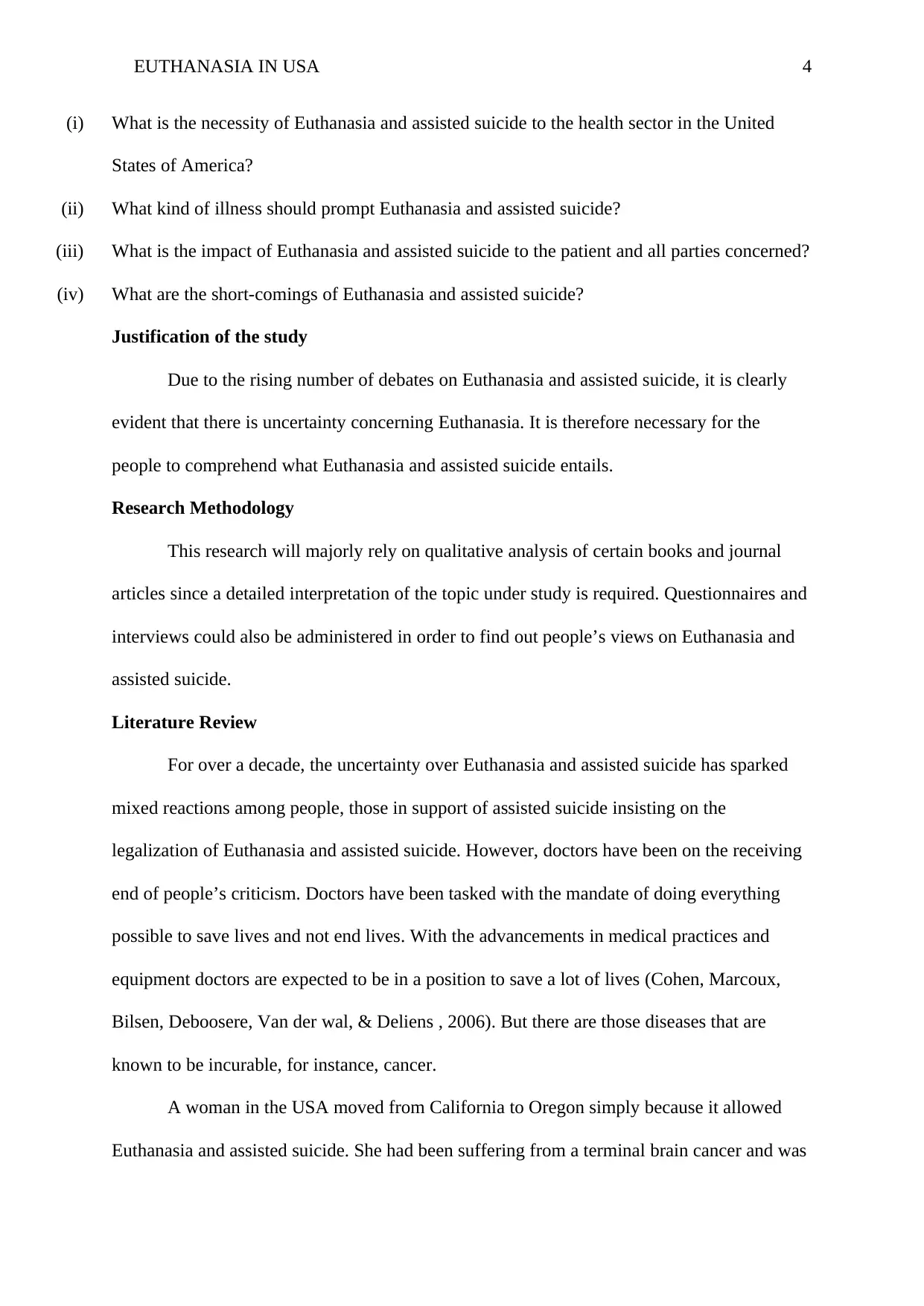
EUTHANASIA IN USA 4
(i) What is the necessity of Euthanasia and assisted suicide to the health sector in the United
States of America?
(ii) What kind of illness should prompt Euthanasia and assisted suicide?
(iii) What is the impact of Euthanasia and assisted suicide to the patient and all parties concerned?
(iv) What are the short-comings of Euthanasia and assisted suicide?
Justification of the study
Due to the rising number of debates on Euthanasia and assisted suicide, it is clearly
evident that there is uncertainty concerning Euthanasia. It is therefore necessary for the
people to comprehend what Euthanasia and assisted suicide entails.
Research Methodology
This research will majorly rely on qualitative analysis of certain books and journal
articles since a detailed interpretation of the topic under study is required. Questionnaires and
interviews could also be administered in order to find out people’s views on Euthanasia and
assisted suicide.
Literature Review
For over a decade, the uncertainty over Euthanasia and assisted suicide has sparked
mixed reactions among people, those in support of assisted suicide insisting on the
legalization of Euthanasia and assisted suicide. However, doctors have been on the receiving
end of people’s criticism. Doctors have been tasked with the mandate of doing everything
possible to save lives and not end lives. With the advancements in medical practices and
equipment doctors are expected to be in a position to save a lot of lives (Cohen, Marcoux,
Bilsen, Deboosere, Van der wal, & Deliens , 2006). But there are those diseases that are
known to be incurable, for instance, cancer.
A woman in the USA moved from California to Oregon simply because it allowed
Euthanasia and assisted suicide. She had been suffering from a terminal brain cancer and was
(i) What is the necessity of Euthanasia and assisted suicide to the health sector in the United
States of America?
(ii) What kind of illness should prompt Euthanasia and assisted suicide?
(iii) What is the impact of Euthanasia and assisted suicide to the patient and all parties concerned?
(iv) What are the short-comings of Euthanasia and assisted suicide?
Justification of the study
Due to the rising number of debates on Euthanasia and assisted suicide, it is clearly
evident that there is uncertainty concerning Euthanasia. It is therefore necessary for the
people to comprehend what Euthanasia and assisted suicide entails.
Research Methodology
This research will majorly rely on qualitative analysis of certain books and journal
articles since a detailed interpretation of the topic under study is required. Questionnaires and
interviews could also be administered in order to find out people’s views on Euthanasia and
assisted suicide.
Literature Review
For over a decade, the uncertainty over Euthanasia and assisted suicide has sparked
mixed reactions among people, those in support of assisted suicide insisting on the
legalization of Euthanasia and assisted suicide. However, doctors have been on the receiving
end of people’s criticism. Doctors have been tasked with the mandate of doing everything
possible to save lives and not end lives. With the advancements in medical practices and
equipment doctors are expected to be in a position to save a lot of lives (Cohen, Marcoux,
Bilsen, Deboosere, Van der wal, & Deliens , 2006). But there are those diseases that are
known to be incurable, for instance, cancer.
A woman in the USA moved from California to Oregon simply because it allowed
Euthanasia and assisted suicide. She had been suffering from a terminal brain cancer and was
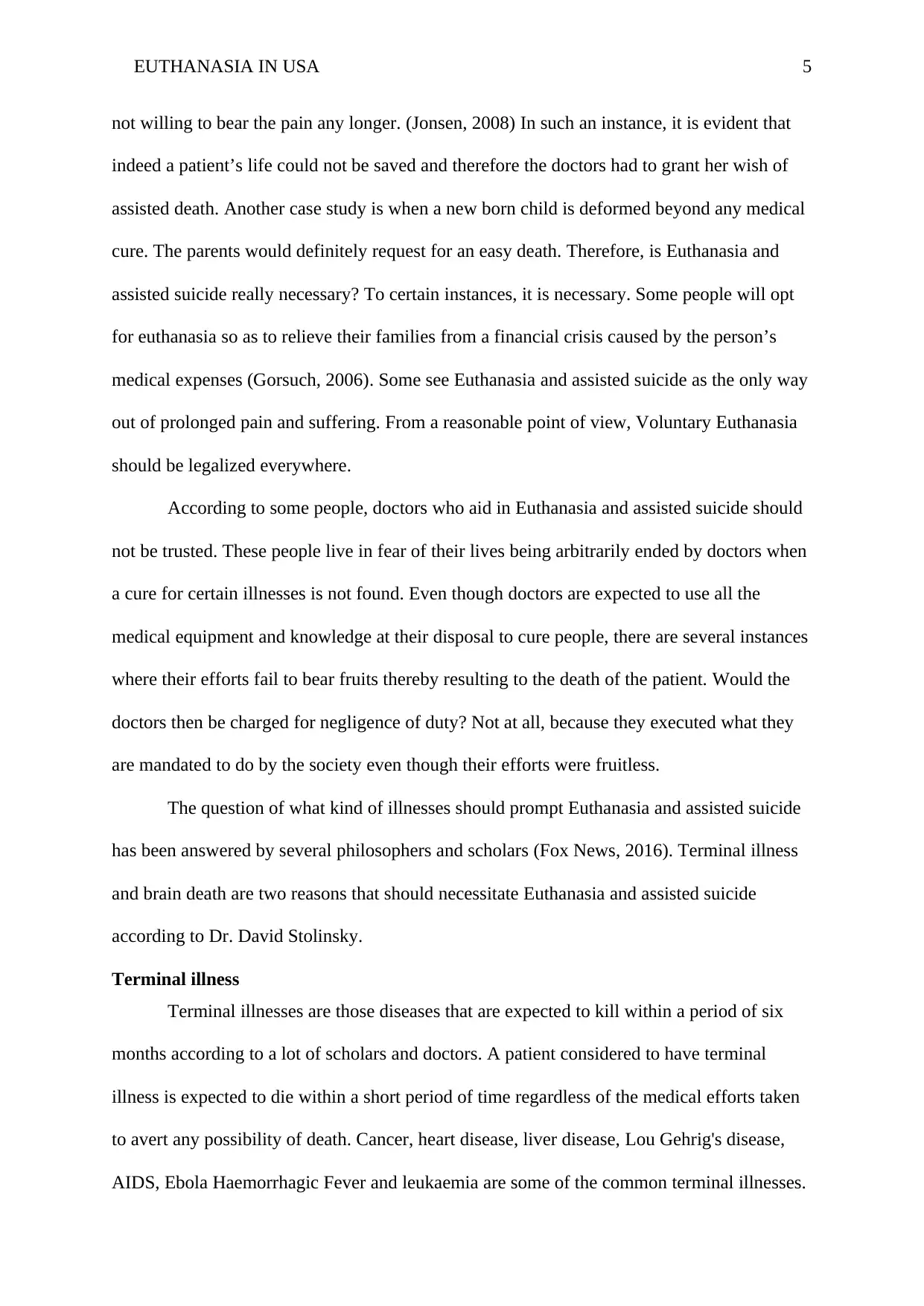
EUTHANASIA IN USA 5
not willing to bear the pain any longer. (Jonsen, 2008) In such an instance, it is evident that
indeed a patient’s life could not be saved and therefore the doctors had to grant her wish of
assisted death. Another case study is when a new born child is deformed beyond any medical
cure. The parents would definitely request for an easy death. Therefore, is Euthanasia and
assisted suicide really necessary? To certain instances, it is necessary. Some people will opt
for euthanasia so as to relieve their families from a financial crisis caused by the person’s
medical expenses (Gorsuch, 2006). Some see Euthanasia and assisted suicide as the only way
out of prolonged pain and suffering. From a reasonable point of view, Voluntary Euthanasia
should be legalized everywhere.
According to some people, doctors who aid in Euthanasia and assisted suicide should
not be trusted. These people live in fear of their lives being arbitrarily ended by doctors when
a cure for certain illnesses is not found. Even though doctors are expected to use all the
medical equipment and knowledge at their disposal to cure people, there are several instances
where their efforts fail to bear fruits thereby resulting to the death of the patient. Would the
doctors then be charged for negligence of duty? Not at all, because they executed what they
are mandated to do by the society even though their efforts were fruitless.
The question of what kind of illnesses should prompt Euthanasia and assisted suicide
has been answered by several philosophers and scholars (Fox News, 2016). Terminal illness
and brain death are two reasons that should necessitate Euthanasia and assisted suicide
according to Dr. David Stolinsky.
Terminal illness
Terminal illnesses are those diseases that are expected to kill within a period of six
months according to a lot of scholars and doctors. A patient considered to have terminal
illness is expected to die within a short period of time regardless of the medical efforts taken
to avert any possibility of death. Cancer, heart disease, liver disease, Lou Gehrig's disease,
AIDS, Ebola Haemorrhagic Fever and leukaemia are some of the common terminal illnesses.
not willing to bear the pain any longer. (Jonsen, 2008) In such an instance, it is evident that
indeed a patient’s life could not be saved and therefore the doctors had to grant her wish of
assisted death. Another case study is when a new born child is deformed beyond any medical
cure. The parents would definitely request for an easy death. Therefore, is Euthanasia and
assisted suicide really necessary? To certain instances, it is necessary. Some people will opt
for euthanasia so as to relieve their families from a financial crisis caused by the person’s
medical expenses (Gorsuch, 2006). Some see Euthanasia and assisted suicide as the only way
out of prolonged pain and suffering. From a reasonable point of view, Voluntary Euthanasia
should be legalized everywhere.
According to some people, doctors who aid in Euthanasia and assisted suicide should
not be trusted. These people live in fear of their lives being arbitrarily ended by doctors when
a cure for certain illnesses is not found. Even though doctors are expected to use all the
medical equipment and knowledge at their disposal to cure people, there are several instances
where their efforts fail to bear fruits thereby resulting to the death of the patient. Would the
doctors then be charged for negligence of duty? Not at all, because they executed what they
are mandated to do by the society even though their efforts were fruitless.
The question of what kind of illnesses should prompt Euthanasia and assisted suicide
has been answered by several philosophers and scholars (Fox News, 2016). Terminal illness
and brain death are two reasons that should necessitate Euthanasia and assisted suicide
according to Dr. David Stolinsky.
Terminal illness
Terminal illnesses are those diseases that are expected to kill within a period of six
months according to a lot of scholars and doctors. A patient considered to have terminal
illness is expected to die within a short period of time regardless of the medical efforts taken
to avert any possibility of death. Cancer, heart disease, liver disease, Lou Gehrig's disease,
AIDS, Ebola Haemorrhagic Fever and leukaemia are some of the common terminal illnesses.
⊘ This is a preview!⊘
Do you want full access?
Subscribe today to unlock all pages.

Trusted by 1+ million students worldwide
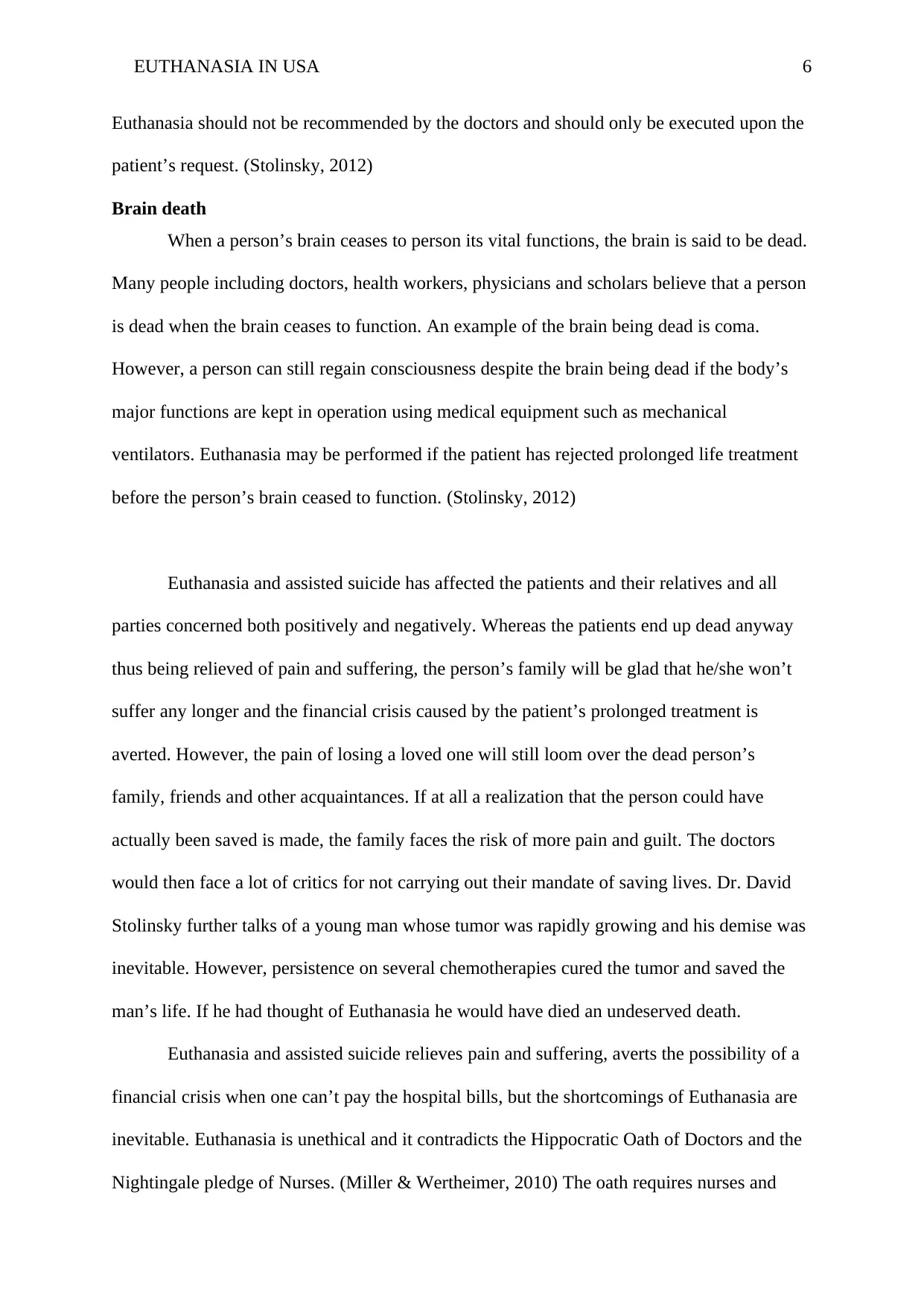
EUTHANASIA IN USA 6
Euthanasia should not be recommended by the doctors and should only be executed upon the
patient’s request. (Stolinsky, 2012)
Brain death
When a person’s brain ceases to person its vital functions, the brain is said to be dead.
Many people including doctors, health workers, physicians and scholars believe that a person
is dead when the brain ceases to function. An example of the brain being dead is coma.
However, a person can still regain consciousness despite the brain being dead if the body’s
major functions are kept in operation using medical equipment such as mechanical
ventilators. Euthanasia may be performed if the patient has rejected prolonged life treatment
before the person’s brain ceased to function. (Stolinsky, 2012)
Euthanasia and assisted suicide has affected the patients and their relatives and all
parties concerned both positively and negatively. Whereas the patients end up dead anyway
thus being relieved of pain and suffering, the person’s family will be glad that he/she won’t
suffer any longer and the financial crisis caused by the patient’s prolonged treatment is
averted. However, the pain of losing a loved one will still loom over the dead person’s
family, friends and other acquaintances. If at all a realization that the person could have
actually been saved is made, the family faces the risk of more pain and guilt. The doctors
would then face a lot of critics for not carrying out their mandate of saving lives. Dr. David
Stolinsky further talks of a young man whose tumor was rapidly growing and his demise was
inevitable. However, persistence on several chemotherapies cured the tumor and saved the
man’s life. If he had thought of Euthanasia he would have died an undeserved death.
Euthanasia and assisted suicide relieves pain and suffering, averts the possibility of a
financial crisis when one can’t pay the hospital bills, but the shortcomings of Euthanasia are
inevitable. Euthanasia is unethical and it contradicts the Hippocratic Oath of Doctors and the
Nightingale pledge of Nurses. (Miller & Wertheimer, 2010) The oath requires nurses and
Euthanasia should not be recommended by the doctors and should only be executed upon the
patient’s request. (Stolinsky, 2012)
Brain death
When a person’s brain ceases to person its vital functions, the brain is said to be dead.
Many people including doctors, health workers, physicians and scholars believe that a person
is dead when the brain ceases to function. An example of the brain being dead is coma.
However, a person can still regain consciousness despite the brain being dead if the body’s
major functions are kept in operation using medical equipment such as mechanical
ventilators. Euthanasia may be performed if the patient has rejected prolonged life treatment
before the person’s brain ceased to function. (Stolinsky, 2012)
Euthanasia and assisted suicide has affected the patients and their relatives and all
parties concerned both positively and negatively. Whereas the patients end up dead anyway
thus being relieved of pain and suffering, the person’s family will be glad that he/she won’t
suffer any longer and the financial crisis caused by the patient’s prolonged treatment is
averted. However, the pain of losing a loved one will still loom over the dead person’s
family, friends and other acquaintances. If at all a realization that the person could have
actually been saved is made, the family faces the risk of more pain and guilt. The doctors
would then face a lot of critics for not carrying out their mandate of saving lives. Dr. David
Stolinsky further talks of a young man whose tumor was rapidly growing and his demise was
inevitable. However, persistence on several chemotherapies cured the tumor and saved the
man’s life. If he had thought of Euthanasia he would have died an undeserved death.
Euthanasia and assisted suicide relieves pain and suffering, averts the possibility of a
financial crisis when one can’t pay the hospital bills, but the shortcomings of Euthanasia are
inevitable. Euthanasia is unethical and it contradicts the Hippocratic Oath of Doctors and the
Nightingale pledge of Nurses. (Miller & Wertheimer, 2010) The oath requires nurses and
Paraphrase This Document
Need a fresh take? Get an instant paraphrase of this document with our AI Paraphraser

EUTHANASIA IN USA 7
doctors to uphold utmost respect to human life and practice medicine virtuously. When
doctors engage in Euthanasia and assisted suicide, the right to life is violated. The
Hippocratic Oath is also ignored in that case. Therefore, Euthanasia and assisted suicide
sparks confusion among doctors and nurses. Even if Euthanasia is legalized, the Hippocratic
Oath taken by doctors and nurses will still be violated (Kamalika, 2017). A balance between
the oath, what the law states about right to life and the law legalizing Euthanasia and assisted
suicide should be created. Euthanasia palpably has health benefits therefore doctors should
not be entirely blamed if it is executed.
Hypothesis
The debate on Euthanasia and assisted suicide is a setback to the government and
doctors. The government of United States of America seeks to uphold the right to life and
legalize Euthanasia when its necessity is prompted (Keown, 2002). Voluntary Euthanasia
should be legalized and regulated to avoid its misuse. Doctors should however not use
Euthanasia and assisted suicide as a form of cure (Goila & Pawar, 2009). That would be
considered as murder. A special committee should be formed by the government in order to
ensure that Euthanasia is the only solution to a terminal illness before it is practiced. The
committee should also ensure that the doctors act upon request by the patient to practice
Euthanasia.
PICO Table
Example:
P (patient/problem) Voluntary Euthanasia.
I (intervention/indicator) Legalization of Euthanasia and forming a
committee to monitor its application.
C (comparison) Regulation of Voluntary Euthanasia by
making it illegal to prevent its misuse.
O (outcome) Pain and suffering relief.
doctors to uphold utmost respect to human life and practice medicine virtuously. When
doctors engage in Euthanasia and assisted suicide, the right to life is violated. The
Hippocratic Oath is also ignored in that case. Therefore, Euthanasia and assisted suicide
sparks confusion among doctors and nurses. Even if Euthanasia is legalized, the Hippocratic
Oath taken by doctors and nurses will still be violated (Kamalika, 2017). A balance between
the oath, what the law states about right to life and the law legalizing Euthanasia and assisted
suicide should be created. Euthanasia palpably has health benefits therefore doctors should
not be entirely blamed if it is executed.
Hypothesis
The debate on Euthanasia and assisted suicide is a setback to the government and
doctors. The government of United States of America seeks to uphold the right to life and
legalize Euthanasia when its necessity is prompted (Keown, 2002). Voluntary Euthanasia
should be legalized and regulated to avoid its misuse. Doctors should however not use
Euthanasia and assisted suicide as a form of cure (Goila & Pawar, 2009). That would be
considered as murder. A special committee should be formed by the government in order to
ensure that Euthanasia is the only solution to a terminal illness before it is practiced. The
committee should also ensure that the doctors act upon request by the patient to practice
Euthanasia.
PICO Table
Example:
P (patient/problem) Voluntary Euthanasia.
I (intervention/indicator) Legalization of Euthanasia and forming a
committee to monitor its application.
C (comparison) Regulation of Voluntary Euthanasia by
making it illegal to prevent its misuse.
O (outcome) Pain and suffering relief.
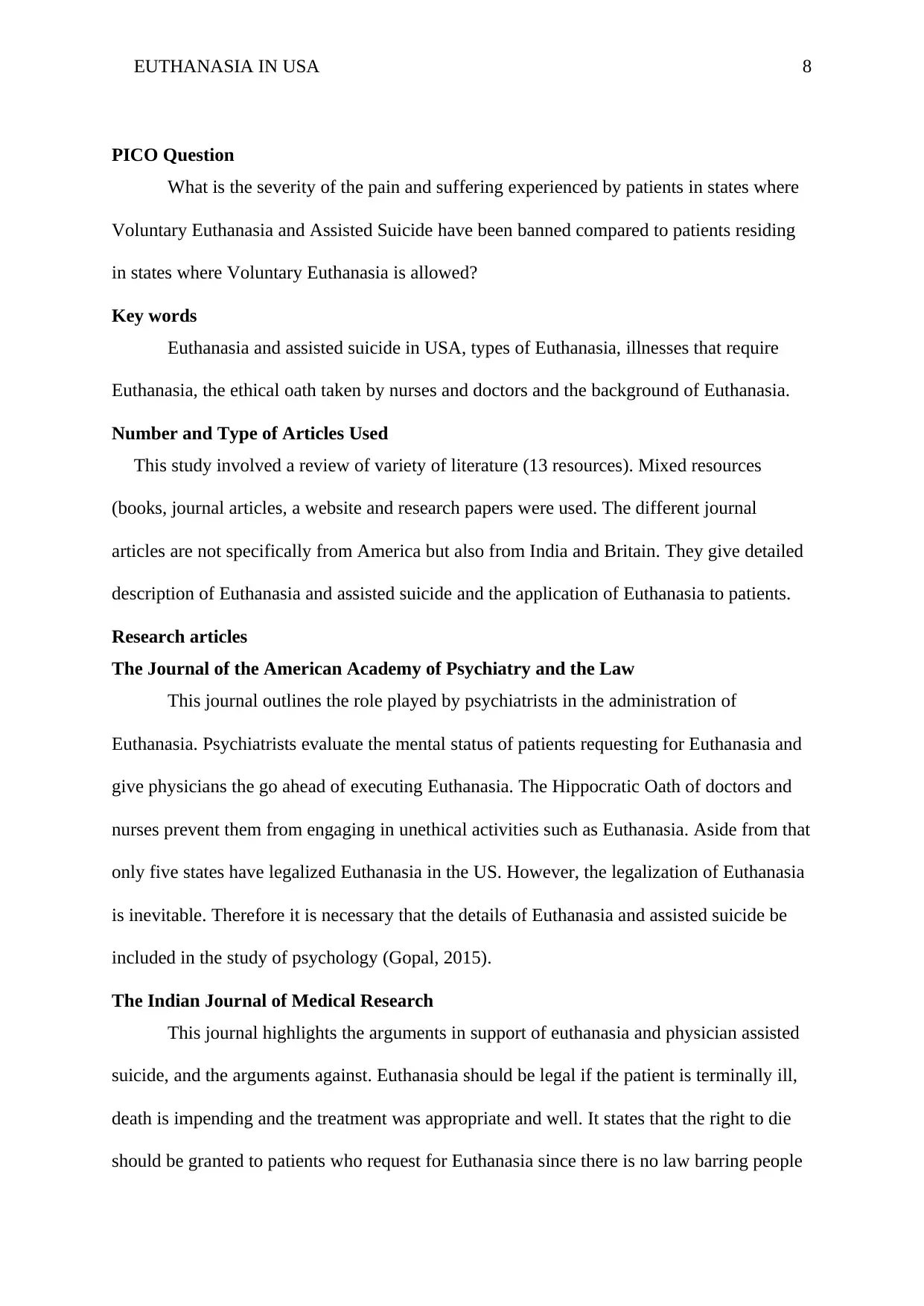
EUTHANASIA IN USA 8
PICO Question
What is the severity of the pain and suffering experienced by patients in states where
Voluntary Euthanasia and Assisted Suicide have been banned compared to patients residing
in states where Voluntary Euthanasia is allowed?
Key words
Euthanasia and assisted suicide in USA, types of Euthanasia, illnesses that require
Euthanasia, the ethical oath taken by nurses and doctors and the background of Euthanasia.
Number and Type of Articles Used
This study involved a review of variety of literature (13 resources). Mixed resources
(books, journal articles, a website and research papers were used. The different journal
articles are not specifically from America but also from India and Britain. They give detailed
description of Euthanasia and assisted suicide and the application of Euthanasia to patients.
Research articles
The Journal of the American Academy of Psychiatry and the Law
This journal outlines the role played by psychiatrists in the administration of
Euthanasia. Psychiatrists evaluate the mental status of patients requesting for Euthanasia and
give physicians the go ahead of executing Euthanasia. The Hippocratic Oath of doctors and
nurses prevent them from engaging in unethical activities such as Euthanasia. Aside from that
only five states have legalized Euthanasia in the US. However, the legalization of Euthanasia
is inevitable. Therefore it is necessary that the details of Euthanasia and assisted suicide be
included in the study of psychology (Gopal, 2015).
The Indian Journal of Medical Research
This journal highlights the arguments in support of euthanasia and physician assisted
suicide, and the arguments against. Euthanasia should be legal if the patient is terminally ill,
death is impending and the treatment was appropriate and well. It states that the right to die
should be granted to patients who request for Euthanasia since there is no law barring people
PICO Question
What is the severity of the pain and suffering experienced by patients in states where
Voluntary Euthanasia and Assisted Suicide have been banned compared to patients residing
in states where Voluntary Euthanasia is allowed?
Key words
Euthanasia and assisted suicide in USA, types of Euthanasia, illnesses that require
Euthanasia, the ethical oath taken by nurses and doctors and the background of Euthanasia.
Number and Type of Articles Used
This study involved a review of variety of literature (13 resources). Mixed resources
(books, journal articles, a website and research papers were used. The different journal
articles are not specifically from America but also from India and Britain. They give detailed
description of Euthanasia and assisted suicide and the application of Euthanasia to patients.
Research articles
The Journal of the American Academy of Psychiatry and the Law
This journal outlines the role played by psychiatrists in the administration of
Euthanasia. Psychiatrists evaluate the mental status of patients requesting for Euthanasia and
give physicians the go ahead of executing Euthanasia. The Hippocratic Oath of doctors and
nurses prevent them from engaging in unethical activities such as Euthanasia. Aside from that
only five states have legalized Euthanasia in the US. However, the legalization of Euthanasia
is inevitable. Therefore it is necessary that the details of Euthanasia and assisted suicide be
included in the study of psychology (Gopal, 2015).
The Indian Journal of Medical Research
This journal highlights the arguments in support of euthanasia and physician assisted
suicide, and the arguments against. Euthanasia should be legal if the patient is terminally ill,
death is impending and the treatment was appropriate and well. It states that the right to die
should be granted to patients who request for Euthanasia since there is no law barring people
⊘ This is a preview!⊘
Do you want full access?
Subscribe today to unlock all pages.

Trusted by 1+ million students worldwide
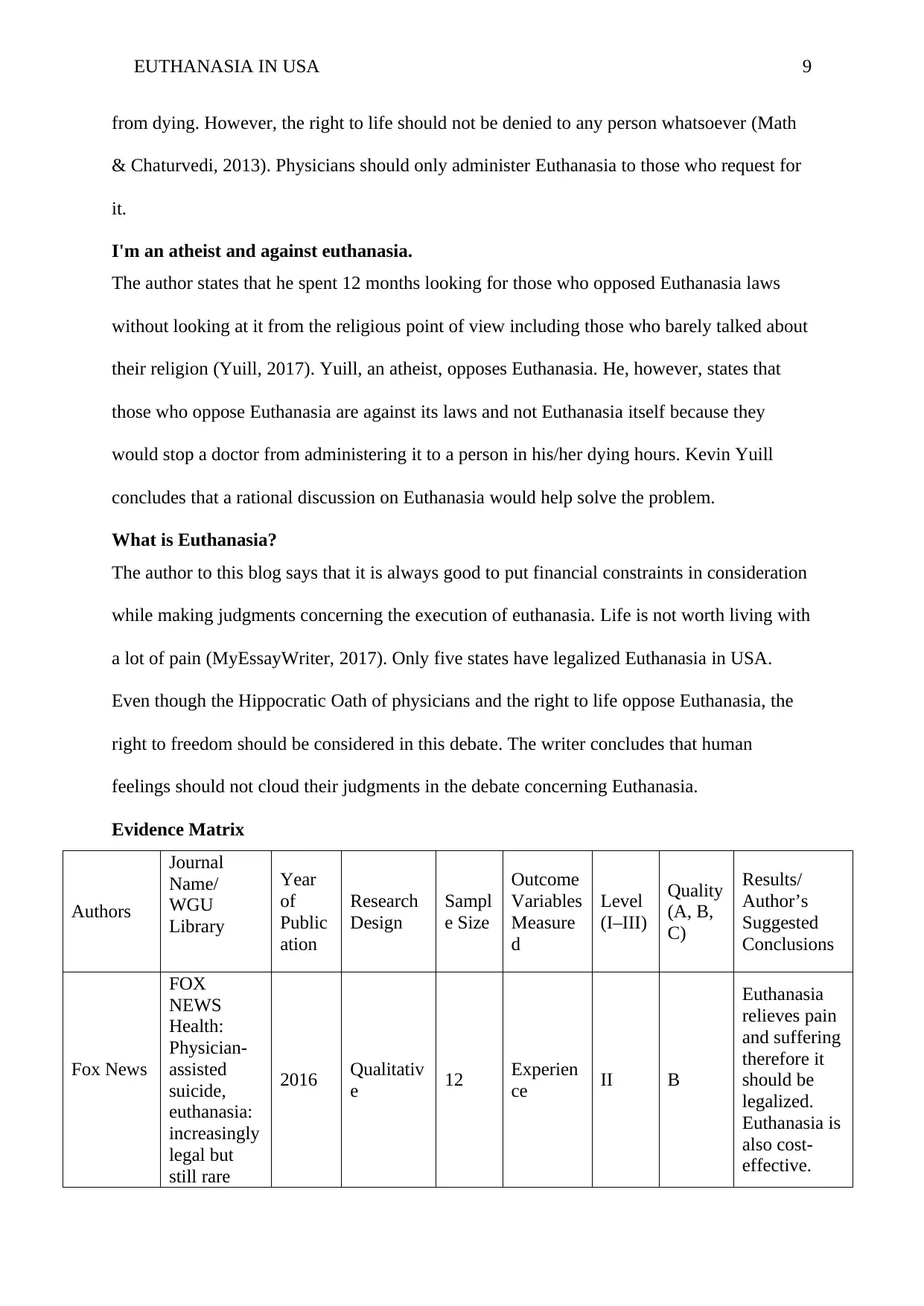
EUTHANASIA IN USA 9
from dying. However, the right to life should not be denied to any person whatsoever (Math
& Chaturvedi, 2013). Physicians should only administer Euthanasia to those who request for
it.
I'm an atheist and against euthanasia.
The author states that he spent 12 months looking for those who opposed Euthanasia laws
without looking at it from the religious point of view including those who barely talked about
their religion (Yuill, 2017). Yuill, an atheist, opposes Euthanasia. He, however, states that
those who oppose Euthanasia are against its laws and not Euthanasia itself because they
would stop a doctor from administering it to a person in his/her dying hours. Kevin Yuill
concludes that a rational discussion on Euthanasia would help solve the problem.
What is Euthanasia?
The author to this blog says that it is always good to put financial constraints in consideration
while making judgments concerning the execution of euthanasia. Life is not worth living with
a lot of pain (MyEssayWriter, 2017). Only five states have legalized Euthanasia in USA.
Even though the Hippocratic Oath of physicians and the right to life oppose Euthanasia, the
right to freedom should be considered in this debate. The writer concludes that human
feelings should not cloud their judgments in the debate concerning Euthanasia.
Evidence Matrix
Authors
Journal
Name/
WGU
Library
Year
of
Public
ation
Research
Design
Sampl
e Size
Outcome
Variables
Measure
d
Level
(I–III)
Quality
(A, B,
C)
Results/
Author’s
Suggested
Conclusions
Fox News
FOX
NEWS
Health:
Physician-
assisted
suicide,
euthanasia:
increasingly
legal but
still rare
2016 Qualitativ
e 12 Experien
ce II B
Euthanasia
relieves pain
and suffering
therefore it
should be
legalized.
Euthanasia is
also cost-
effective.
from dying. However, the right to life should not be denied to any person whatsoever (Math
& Chaturvedi, 2013). Physicians should only administer Euthanasia to those who request for
it.
I'm an atheist and against euthanasia.
The author states that he spent 12 months looking for those who opposed Euthanasia laws
without looking at it from the religious point of view including those who barely talked about
their religion (Yuill, 2017). Yuill, an atheist, opposes Euthanasia. He, however, states that
those who oppose Euthanasia are against its laws and not Euthanasia itself because they
would stop a doctor from administering it to a person in his/her dying hours. Kevin Yuill
concludes that a rational discussion on Euthanasia would help solve the problem.
What is Euthanasia?
The author to this blog says that it is always good to put financial constraints in consideration
while making judgments concerning the execution of euthanasia. Life is not worth living with
a lot of pain (MyEssayWriter, 2017). Only five states have legalized Euthanasia in USA.
Even though the Hippocratic Oath of physicians and the right to life oppose Euthanasia, the
right to freedom should be considered in this debate. The writer concludes that human
feelings should not cloud their judgments in the debate concerning Euthanasia.
Evidence Matrix
Authors
Journal
Name/
WGU
Library
Year
of
Public
ation
Research
Design
Sampl
e Size
Outcome
Variables
Measure
d
Level
(I–III)
Quality
(A, B,
C)
Results/
Author’s
Suggested
Conclusions
Fox News
FOX
NEWS
Health:
Physician-
assisted
suicide,
euthanasia:
increasingly
legal but
still rare
2016 Qualitativ
e 12 Experien
ce II B
Euthanasia
relieves pain
and suffering
therefore it
should be
legalized.
Euthanasia is
also cost-
effective.
Paraphrase This Document
Need a fresh take? Get an instant paraphrase of this document with our AI Paraphraser
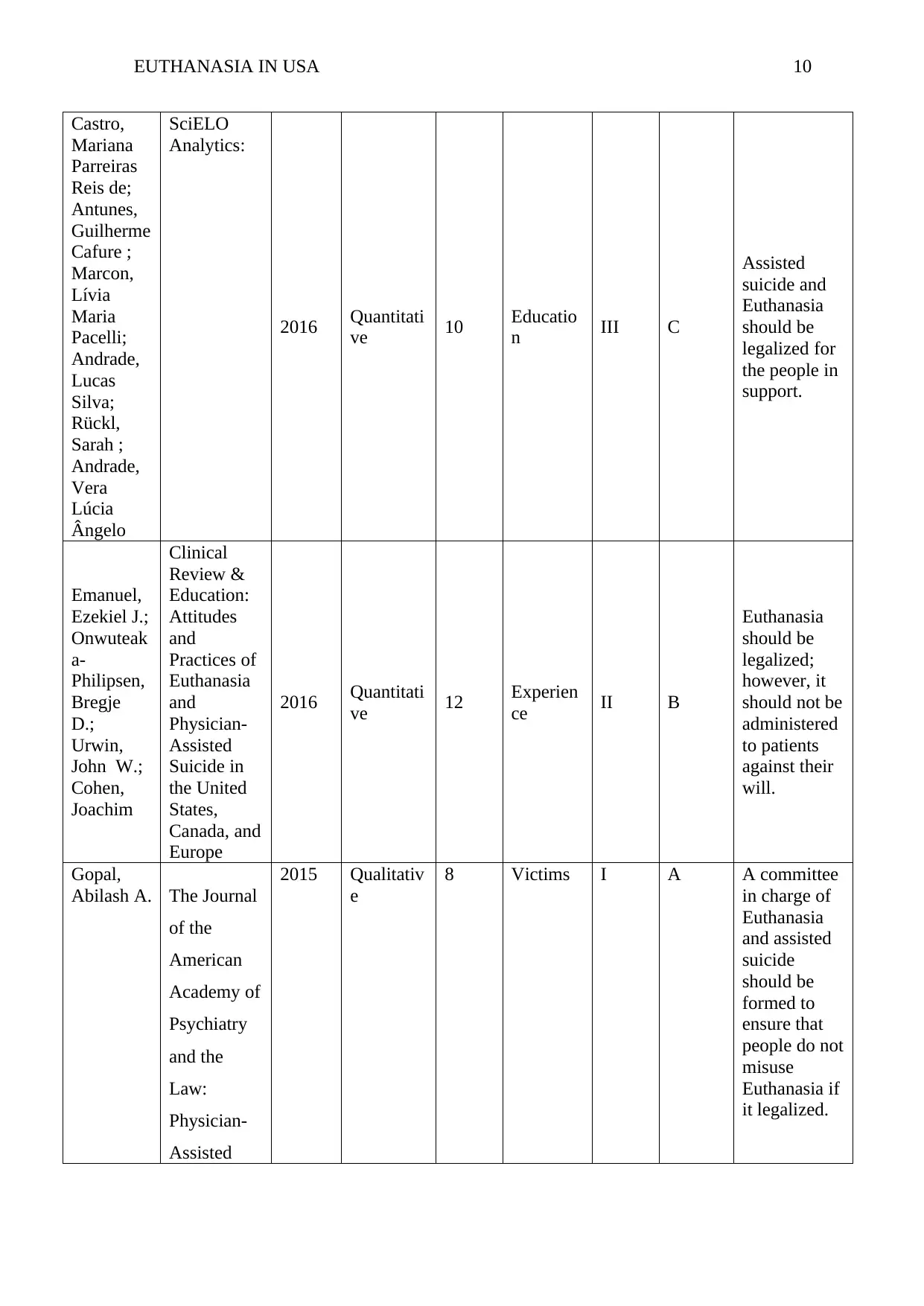
EUTHANASIA IN USA 10
Castro,
Mariana
Parreiras
Reis de;
Antunes,
Guilherme
Cafure ;
Marcon,
Lívia
Maria
Pacelli;
Andrade,
Lucas
Silva;
Rückl,
Sarah ;
Andrade,
Vera
Lúcia
Ângelo
SciELO
Analytics:
2016 Quantitati
ve 10 Educatio
n III C
Assisted
suicide and
Euthanasia
should be
legalized for
the people in
support.
Emanuel,
Ezekiel J.;
Onwuteak
a-
Philipsen,
Bregje
D.;
Urwin,
John W.;
Cohen,
Joachim
Clinical
Review &
Education:
Attitudes
and
Practices of
Euthanasia
and
Physician-
Assisted
Suicide in
the United
States,
Canada, and
Europe
2016 Quantitati
ve 12 Experien
ce II B
Euthanasia
should be
legalized;
however, it
should not be
administered
to patients
against their
will.
Gopal,
Abilash A. The Journal
of the
American
Academy of
Psychiatry
and the
Law:
Physician-
Assisted
2015 Qualitativ
e
8 Victims I A A committee
in charge of
Euthanasia
and assisted
suicide
should be
formed to
ensure that
people do not
misuse
Euthanasia if
it legalized.
Castro,
Mariana
Parreiras
Reis de;
Antunes,
Guilherme
Cafure ;
Marcon,
Lívia
Maria
Pacelli;
Andrade,
Lucas
Silva;
Rückl,
Sarah ;
Andrade,
Vera
Lúcia
Ângelo
SciELO
Analytics:
2016 Quantitati
ve 10 Educatio
n III C
Assisted
suicide and
Euthanasia
should be
legalized for
the people in
support.
Emanuel,
Ezekiel J.;
Onwuteak
a-
Philipsen,
Bregje
D.;
Urwin,
John W.;
Cohen,
Joachim
Clinical
Review &
Education:
Attitudes
and
Practices of
Euthanasia
and
Physician-
Assisted
Suicide in
the United
States,
Canada, and
Europe
2016 Quantitati
ve 12 Experien
ce II B
Euthanasia
should be
legalized;
however, it
should not be
administered
to patients
against their
will.
Gopal,
Abilash A. The Journal
of the
American
Academy of
Psychiatry
and the
Law:
Physician-
Assisted
2015 Qualitativ
e
8 Victims I A A committee
in charge of
Euthanasia
and assisted
suicide
should be
formed to
ensure that
people do not
misuse
Euthanasia if
it legalized.
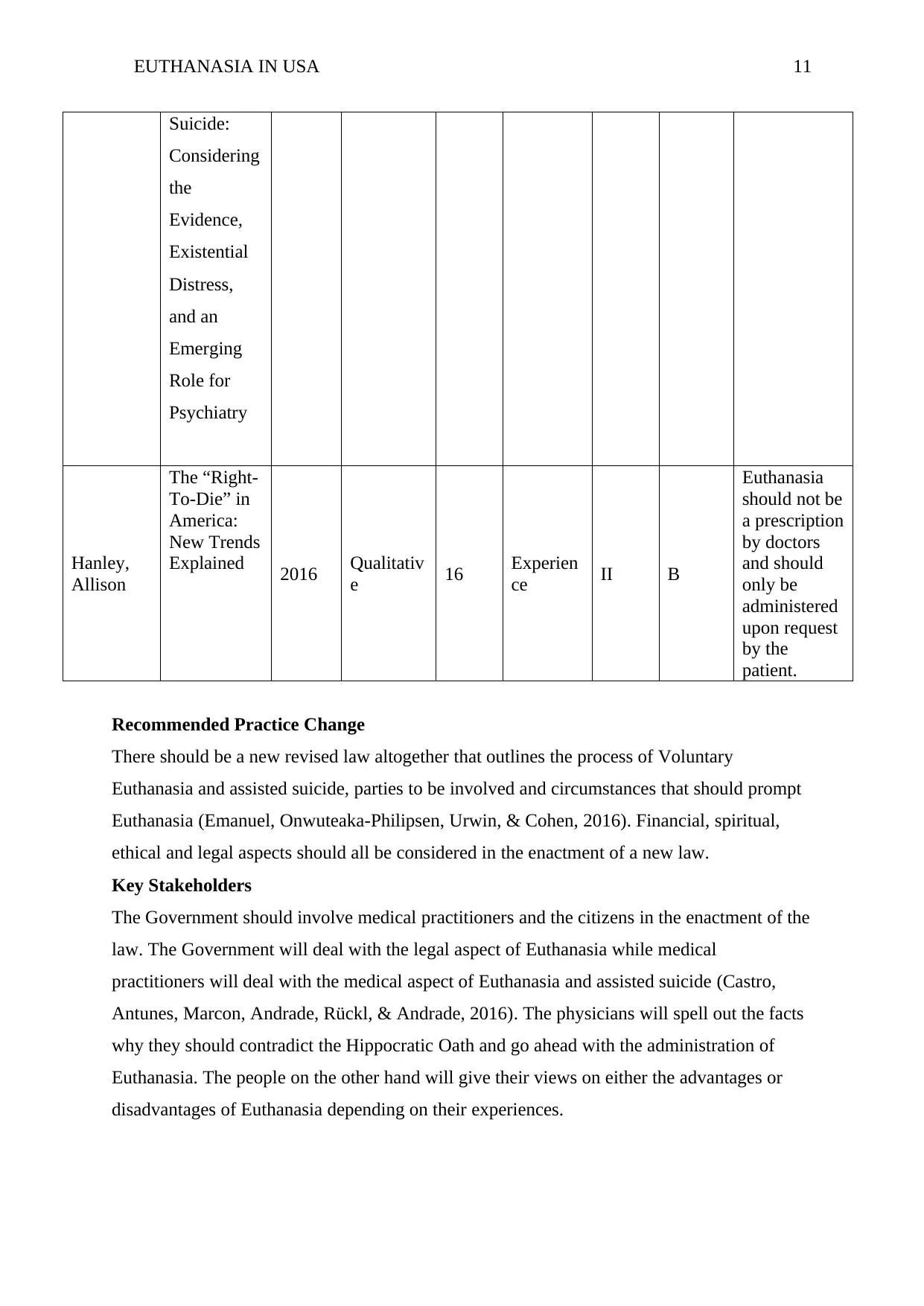
EUTHANASIA IN USA 11
Suicide:
Considering
the
Evidence,
Existential
Distress,
and an
Emerging
Role for
Psychiatry
Hanley,
Allison
The “Right-
To-Die” in
America:
New Trends
Explained 2016 Qualitativ
e 16 Experien
ce II B
Euthanasia
should not be
a prescription
by doctors
and should
only be
administered
upon request
by the
patient.
Recommended Practice Change
There should be a new revised law altogether that outlines the process of Voluntary
Euthanasia and assisted suicide, parties to be involved and circumstances that should prompt
Euthanasia (Emanuel, Onwuteaka-Philipsen, Urwin, & Cohen, 2016). Financial, spiritual,
ethical and legal aspects should all be considered in the enactment of a new law.
Key Stakeholders
The Government should involve medical practitioners and the citizens in the enactment of the
law. The Government will deal with the legal aspect of Euthanasia while medical
practitioners will deal with the medical aspect of Euthanasia and assisted suicide (Castro,
Antunes, Marcon, Andrade, Rückl, & Andrade, 2016). The physicians will spell out the facts
why they should contradict the Hippocratic Oath and go ahead with the administration of
Euthanasia. The people on the other hand will give their views on either the advantages or
disadvantages of Euthanasia depending on their experiences.
Suicide:
Considering
the
Evidence,
Existential
Distress,
and an
Emerging
Role for
Psychiatry
Hanley,
Allison
The “Right-
To-Die” in
America:
New Trends
Explained 2016 Qualitativ
e 16 Experien
ce II B
Euthanasia
should not be
a prescription
by doctors
and should
only be
administered
upon request
by the
patient.
Recommended Practice Change
There should be a new revised law altogether that outlines the process of Voluntary
Euthanasia and assisted suicide, parties to be involved and circumstances that should prompt
Euthanasia (Emanuel, Onwuteaka-Philipsen, Urwin, & Cohen, 2016). Financial, spiritual,
ethical and legal aspects should all be considered in the enactment of a new law.
Key Stakeholders
The Government should involve medical practitioners and the citizens in the enactment of the
law. The Government will deal with the legal aspect of Euthanasia while medical
practitioners will deal with the medical aspect of Euthanasia and assisted suicide (Castro,
Antunes, Marcon, Andrade, Rückl, & Andrade, 2016). The physicians will spell out the facts
why they should contradict the Hippocratic Oath and go ahead with the administration of
Euthanasia. The people on the other hand will give their views on either the advantages or
disadvantages of Euthanasia depending on their experiences.
⊘ This is a preview!⊘
Do you want full access?
Subscribe today to unlock all pages.

Trusted by 1+ million students worldwide
1 out of 15
Related Documents
Your All-in-One AI-Powered Toolkit for Academic Success.
+13062052269
info@desklib.com
Available 24*7 on WhatsApp / Email
![[object Object]](/_next/static/media/star-bottom.7253800d.svg)
Unlock your academic potential
Copyright © 2020–2025 A2Z Services. All Rights Reserved. Developed and managed by ZUCOL.





